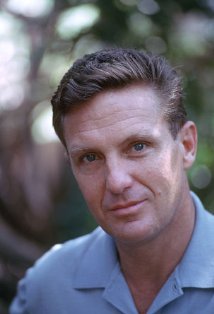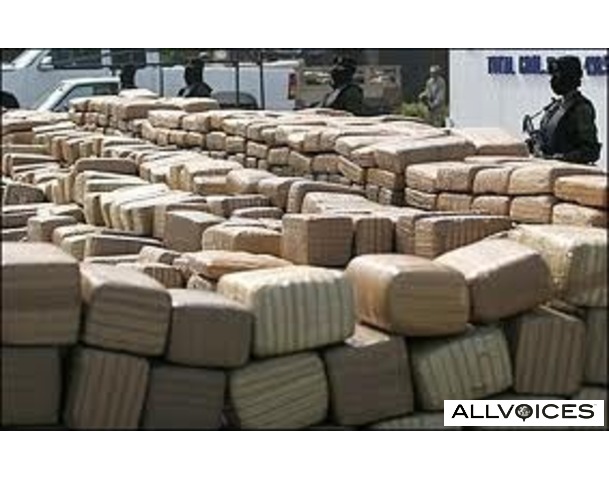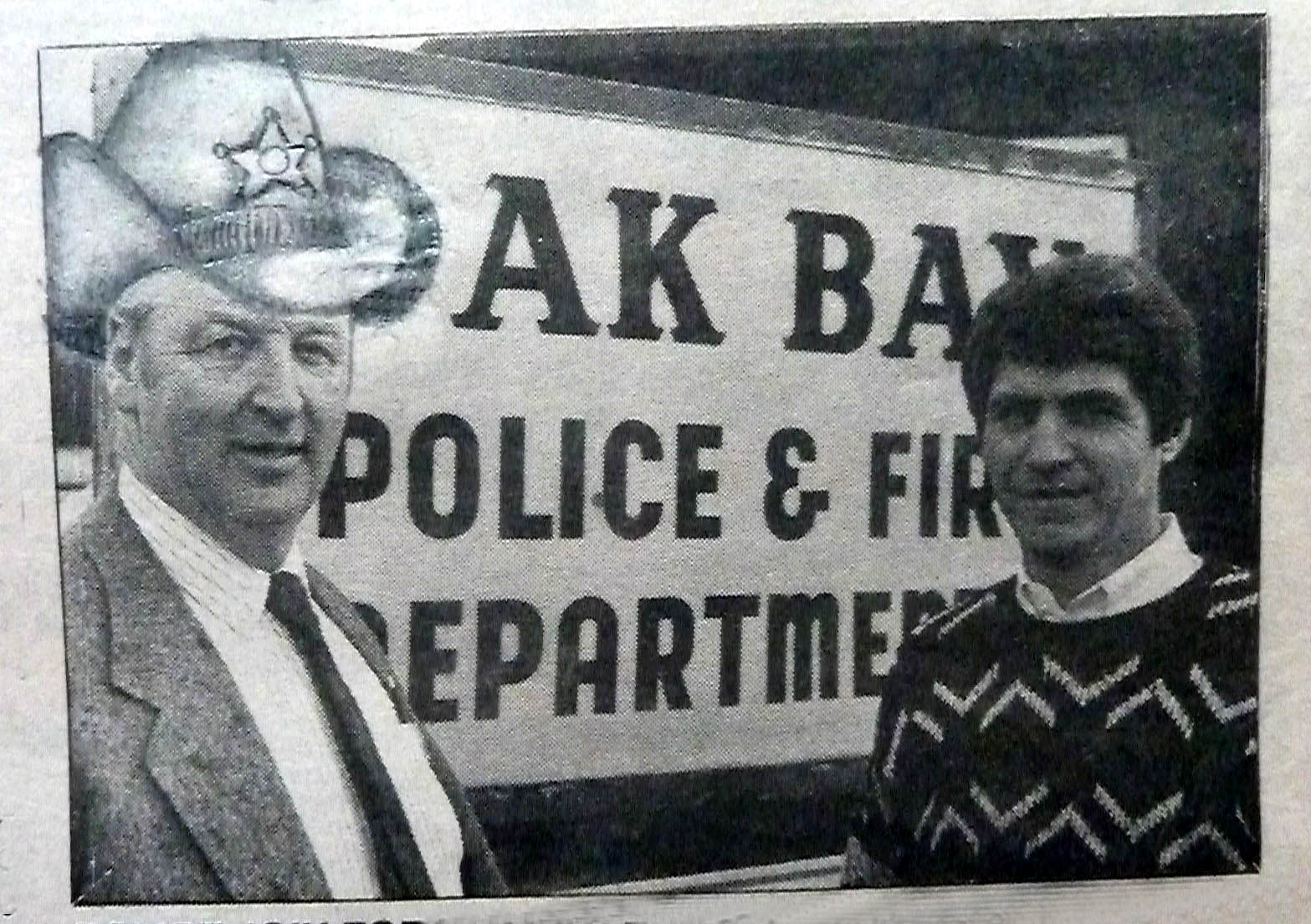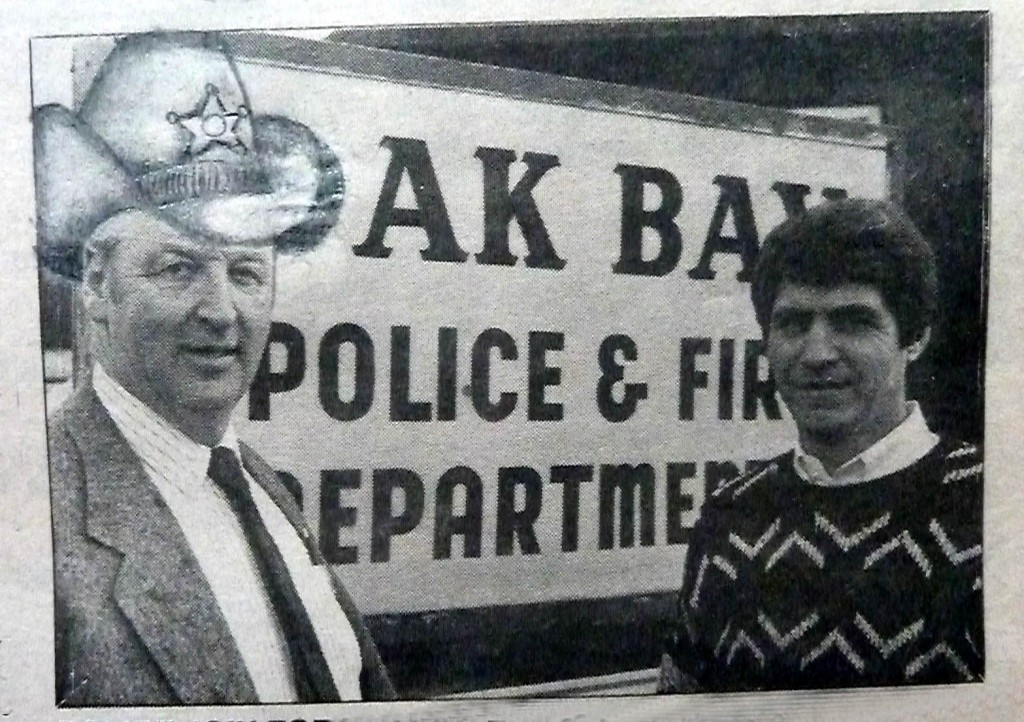International Pursuit of a Felon
Photo (Oak Bay Star): Detective Sergeant Al Campbell (left) and FBI Agent, Bob Hanis from South Bend, Indiana.
January 15, 2012:For a recent similar case in Canada involving an estimated one billion in marihuana, read the National Post article: A Great Movie Script
A Soft Landing in Canada
Do not get on the FBI’s Most Wanted list, or have your mugshot broadcast around the world as that could be the beginning of the end of a financially rewarding career in crime. Such was the case of one young man who dared try to hide behind the Tweed Curtain in Oak Bay, British Columbia. For Constable Al Campbell it was an exciting time as he chased one of the FBI’s Most Wanted through the streets of Oak Bay. The story began many months before in Indiana…
Unsolved Mysteries – Joins the Chase
In 1987 Robert Stack began hosting a new TV Series, Unsolved Mysteries, that soon became a perennial favourite. In addition to two or three feature articles each week, the hour-long  production profiled persons on the “FBI Most Wanted” list. On January 9, 1991, the program included two international drug traffickers – Thomas Paul Hickey and William James McCarthy, both men then in their early thirties.
production profiled persons on the “FBI Most Wanted” list. On January 9, 1991, the program included two international drug traffickers – Thomas Paul Hickey and William James McCarthy, both men then in their early thirties.
Photo: Robert Stack, who was a periodic regular host of the show through the 1980s and 90s, was better known as the handsome, no-nonsense Elliot Ness in the TV and movie series the ‘The Untouchables’.
In late 1986 Indiana State Police indicted Hickey and McCartney on forty-three counts including drug trafficking, participating in a continuing criminal enterprise, possession and conspiracy to distribute marihuana, obstruction of justice, interstate transportation in aid of racketeering and, for good measure, a charge that was the undoing of many mobsters in the ‘Untouchables’, income tax evasion.
The broad-ranging criminal enterprise built by Hickey and McCarthy from early 1979 through 1986 was spurred on by a high demand for marihuana that had developed during the ’60’s and ’70’s “hippie years” on College and University campuses across North America. In the 1980s the taste for that exotic weed soon spread to the business and professional community as college and university students, after graduation, were not about to leave behind all the perquisites of campus life. While Mary Jane was bulky to transport and distribute, Hickey and McCarthy overcame the challenge by contracting a fleet of semi-trailers to move the parcels to dozens of cities across the United States.
Why take the chance? In short, the chances of being caught were minima l and the profits immense. One tractor-trailer load could easily conceal up to fifty or sixty, 20 to 30-pound bales of ‘ready to toke’ marihuana and when delivered to a major centre could generate as much as $3 million. Over their eight-year run, it was estimated the partners, who were well established in the business by their late twenties, netted an estimated $100 million tax-free dollars, a rather handsome return on gross income that was estimated to have reached half billion.
l and the profits immense. One tractor-trailer load could easily conceal up to fifty or sixty, 20 to 30-pound bales of ‘ready to toke’ marihuana and when delivered to a major centre could generate as much as $3 million. Over their eight-year run, it was estimated the partners, who were well established in the business by their late twenties, netted an estimated $100 million tax-free dollars, a rather handsome return on gross income that was estimated to have reached half billion.
Photo: Columbian mercenaries stand guard over hundreds of bales of marihuana being readied for shipment to the USA. While bulk always posed a challenge in moving large quantities of marihuana (versus heroin and cocaine), this did not deter hundreds of ingenious importers/exporters from finding the ways and means of surreptitiously infiltrating thousands of metric tons it into the US by land, sea and air. It was another demonstration of the entrepreneurial spirit being alive and well in North and South America.
Life was good to the traffickers and, one would suppose, the men felt they were too young to walk away from a business they had worked hard to build. They were innovative, hard-working entrepreneurs of the first order but sinister forces were at work in their organization. The challenge for Hickey and McCarthy was one which befalls many successful criminal enterprises – a high-level employee or partner getting caught and becoming a police informant. Having gained that informant access to the burgeoning enterprise, the Indiana State Police and FBI, through wiretaps and other investigative means were able to slowly close the net around the senior partners. In the fall of 1986, the trap sprang shut.
The charges faced by Hickey and McCarthy if convicted could net them a hundred years in a US Federal Penitentiary. Even with fifty years off for good behaviour, it was not a glowing prospect for these young, newly minted multi-millionaires.
 As often the case with multi-millionaire drug dealers and billionaire wall street traders, their nearly limitless supply of cash allowed them to purchase the best ‘legal aid’ in the country, a service well beyond the reach of ordinary citizens. While the initial arrest necessitated a short term of incarceration, this was nothing more than an inconvenience to be overcome.
As often the case with multi-millionaire drug dealers and billionaire wall street traders, their nearly limitless supply of cash allowed them to purchase the best ‘legal aid’ in the country, a service well beyond the reach of ordinary citizens. While the initial arrest necessitated a short term of incarceration, this was nothing more than an inconvenience to be overcome.
Photo: Stacks of cash is the stock and trade of drug traffickers. Moving the money was relatively simple and laundering it back into the system easily accomplished by cooperative bankers, businessmen and lawyers around the world.
The legal team easily satisfied the court the men were otherwise “stalwart citizens and family men with strong ties to the community to South Bend. The two certainly did not present a flight risk!” A short time later each man posted one million in cash bail, money that would revert to state coffers after the first missed court appearance. In a perverse way, this all made good sense – it kept everyone in the legal system gainfully employed, it gave politicians, the press and other ‘law and order types’ much to complain about and it helped to flesh out popular TV programs – all this on the back of that ‘demon weed’.
Over the next five years the Indiana State Police, FBI and other agencies maintained an active file on the Fugitive Watch List. Good leads were generated for McCarthy, his wife and daughter, first, in Colorado, then Florida, and, later, Melbourne, Australia. Finally, in 1990, he and his family caught a flight from Sidney, Australia, to Vancouver, British Columbia. At each location, the McCarthy’s managed to move on just before the police moved in using new identities backed up by various documents using assumed names. Hickey, on the other hand, managed to stay well below police radar in the community of Baine Bridge Island in Washington State.
That McCarthy managed to elude police in several parts of the world suggested he had developed a number of effective counter-surveillance techniques and, as well, there was likely a fair bit of good luck involved. As an example, after having lived for several months in Melbourne, McCarthy and his family fled just 24 hours before police closed in. The family arrived in Vancouver on May 1, 1990, and passed through Canadian customs at YVR using fake documents, just a few hours before the FBI APB was received. With no further sightings over the next few months, State and FBI officials arranged to have the two profiled on Unsolved Mysteries. The show aired on Wednesday, January 9, 1991, to an audience estimated at 40 million in the US and Canada.
The Net Closes in Oak Bay, British Columbia
On Thursday, January 10, 1991, a resident of Oak Bay dropped by the Police Office with an interesting story to tell. Sergeant Al Campbell, an officer having over 25 years service with Oak Bay and then in charge of the Detective Office, spoke to the man.
The gentleman explained that as part of his regular routine he went to the Oak Bay Rec Centre for a game of tennis in the bubble, and earlier that morning had picked up a match with a casual acquaintance. During the match, it suddenly struck him how much the man resembled one of the two men profiled on the FBI’s Most Wanted section of Unsolved Mysteries broadcast the previous evening.
After the match the two had coffee and although they chatted about several subjects, the complainant avoided making any mention of having watched the TV show. After coffee the gentleman, the witness headed home and mentioned his suspicions his wife. While she found this interesting she was skeptical that the man was indeed the man profiled on the Most Wanted T.V. show. Never-the-less, she felt it would be worthwhile advising the police.
Det/Sgt. Campbell also found the story interesting and ask the man to stop going to the Rec Centre for the time being in order to avoid making a slip that might spook the suspect if it turned out he was, in fact, the wanted man. This was agreed and Campbell began to gather background research.
Sergeant Campbell was a good choice for this case as he was not only methodical, he was also a man who trusted his policing instincts. Campbell was well aware eye witness identification was often faulty at best and dead wrong at worst. He knew that just “resembling” a person profiled on a popular TV show was not insufficient grounds for arrest and detention. The matter would require more leg-work to not only identify the suspect who had been playing tennis at the Rec Centre but to then develop a background that might reveal him to be one and the same as the FBI fugitive. This had to be done with great care in order to avoid spooking the man.
The first steps did not take long as Rec Centre schedule showed a man by name of Allan Daley had booked a tennis court in that particular slot and as having played a game with the complainant. Daley was also the holder of an Oak Bay Rec monthly pass in the name of Allan Daley whose address was given as 1460 Oliver Street in South Oak Bay. To ensure general patrols did not accidentally intrude upon the situation, Campbell briefed each shift to avoid, whenever possible, spending time near the residence.
Over the next few days, Campbell continued to draw together as much information as possible, first on the US fugitive, then on the Oak Bay resident. He followed two routes: First, developing leads that might connect Daley back to South Bend, Indiana and the person of William McCarthy and, second, compiling evidence that Daley and his family were illegally in Canada using assumed names.
Both the Canadian Police Information Centre (CPIC) in Ottawa and the National Crime Information Centre (NCIC) in Washington, DC, were great systems but, in this case, were unlikely to yield any useful information unless McCarthy had at one time used the alias Daley. Photos and fingerprints were requested from the FBI and Indiana State Police.
What Campbell needed was reasonable and probable grounds (R&P) not only to arrest but strong enough to convince a Judge to hold the man until positive fingerprint identification could be made. The later could take a few days so the arrest had to be solid in order to keep the man in custody pending confirmation. For the suspect, again getting bail would be better than holding a winning lottery ticket, it would mean at least a few more years of freedom as he outpaced pursuing police officers.
To cover his bets Campbell set up casual surveillance of the house to determine the daily routines of the suspect and his family. If it appeared the suspect was on the move, he would immediately move in for the arrest. As it turned out one of the patrol officers was a friend of a homeowner across the street so a surveillance point was established at that point. Over the next few days, a woman in her mid-thirties left the house each morning and drove a young girl, about six years old, to the Uplands Elementary School in North Oak Bay. Increasing the ages from 1986, the residents matched the McCarthy family.
A quiet chat with the Uplands School Principal revealed the Daley girl had the same first name, day and month of birth as McCarthy’s daughter, however her last name and year of birth were different. This was solid circumstantial evidence as it was assumed it would be easy to change the girls last name and birth year, but not that easy to change her first name and actual birthday. The girl had been registered in with the school in September but there were no forwarding school reports as it was her first year in school.
A property title search for the Oliver Street property revealed Daley had leased the house under the name of Allen Scott Daley the previous June. The lease agreement, for one year, was paid by cheque on an account that had also been opened the previous June. The vehicle was a short term lease in the name of Daley who was in possession of a valid DL from another jurisdiction – again nothing definitive but highly suspicious.
Canadian Immigration and the RCMP Anti-Drug Profiteering Section could find no record of Allen Scott Daley ever having lived in Canada. A check of the phone records did not reveal anything of particular interest other than a few calls to the small community of Baine Bridge Island in Washington State to a phone registered to one Paul Kelly. There were no calls to Indiana.
By January 21, 1991, Campbell was satisfied Daley was, in fact, William James McCarthy and the decision was made to go ahead with the arrest. As dayshift NOC, Campbell asked if I would prepare and execute a search warrant for the residence.
Not wanting to lose the subject at this point overnight surveillance was doubled and as soon as Mrs McCarthy (Daley) left to take her daughter to school in the morning, officers would move in arrest McCarthy and conduct a search of the house. Two additional officers were assigned to arrest Mrs McCarthy after she had dropped her daughter at school. Arrangements were made with Child Protective Services to pick up the girl and place her in protective care.
Arrest
At 8:30 am as soon as Mrs McCarthy had left with the girl, Detective Campbell and I, along with two patrol officers, entered the house and took McCarthy into custody. The other officers took Mrs McCarthy into custody right after she dropped off her daughter. Both arrests were made without incident.
Campbell recalled McCarthy being in a state of shock: “His eyes were as big as saucers when we handcuffed him and took him from the house. At the police station, he was still shaking when we photographed and fingerprinted him prior to lodging him in cells. He seemed resigned to arrest and at one point stated, ‘I never, ever thought this day would come’. He also expressed his joy of living in Oak Bay with his wife and family stating it was ‘one of the finest places he had ever lived’.
Campbell stated it was also surprising, perhaps a bit ironical, to learn that McCarthy watched the Unsolved Mysteries episode on which he was profiled and that he never imagined he might be recognized.
While at the Oliver Street resident, Constable Dan McLean and I then commenced a methodical search of the entire residence. It seemed certain we would find at least some documentation or other items revealing McCarthy’s true identity. Our search continued for the better part of two hours we went through every nook, cranny, drawer and managed and came up with several helpful documents but what we could not locate were any passports or other stolen or forged documents.
We discussed whether McCarthy may have been secured them in a safety deposit box but ruled that out for if McCarthy and his family were suddenly spooked and had to make a sprint for freedom, they would most certainly need immediate access to documents and cash. They had to be in or around the house.
After scanning every possible outdoor location, we again stopped in the Rec Room and were discussing other possible hiding spots when we both looked at the cast iron wood stove. When we removed the ash catcher, dug down in the ashes, voila, we were rewarded with a large sealed package that containing a dozen of passports, driver’s licences, credit cards and a quantity of cash. The stash included the Daley passports and sufficient information to locate several numbered offshore bank accounts. McCarthy’s would have a hard time explaining these items.
Would Bail Again Free the Accused?
Campbell was advised that Bob Hanis an FBI Special Agent from South Bend, Indiana and Doug Schultz, a Detective Sergeant with the Drug Enforcement Division of the Indiana State Police, were en route to Victoria to attend the Bail and Immigration Hearings. It was fortunate Campbell had everything in order as, at the first bail hearing, McCarthy’s lawyers came very, very close to convincing the Provincial Court Judge to release the suspect on a significant cash bail. Had he been released here is little doubt he and his family would have disappeared as they had done before.
As it was, the Judge did release Mrs McCarthy for reasons that were largely compassionate – her six-year-old daughter was being held by Family Services. Even for the police and prosecutor, it did not seem all that unreasonable even though she was charged under the Immigration Act and with have possessed a forged passport. As she was not charged with any offence related to the US drug case, it seemed likely she would return to her home in Indiana pending her husband being extradited back to the US. It was her misfortune (perhaps poor judgement) that lead to her a life on the run with a fugitive from justice.
Detective Campbell’s excellent police work had paid off where many others had failed. A short time later McCarthy was transferred to Vancouver and after an Immigration Hearing, he was arrested on a US Extradition Warrant. The warrant would hold him in custody for further 45 days while authorities prepared the case for his Extradition Hearing.
As for McCarthy’s partner, Thomas Paul Hickey, as was noted earlier, he was living at Baine Bridge Island in Washington State under the assumed name of Paul James Kelly as this name came up on the LD tolls on Daley’s phone number. In Washington, Hickey had presented himself as an independently wealthy individual having inherited the money. Like McCarthy, Hickey was identified after his profile was shown on Unsolved Mysteries. The two were arrested at around the same time as it seemed likely one being arrested earlier might cause the second person to flee just in case. Police closed in on Kelly shortly before McCarthy was arrested in Oak Bay.
For Oak Bay, it was a high profile arrest that gained considerable praise. When speaking about the accused, FBI Special Agent Hanis stated: “These two men were smart and played it by the book. They prepared as well for their life on the lamb as they had in building a successful criminal enterprise.”
He went on: “Sergeant Campbell and his investigative team at Oak Bay did an excellent job of maintaining surveillance on McCarthy without arousing suspicion and they built a strong case before effecting the arrest. With McCarthy it would have been very easy to slip up and if they  had he and his family would most certainly have again disappeared in a split second. Also, if they had not put together a very strong case McCarthy might very well have been released on bail.” (Comments pulled from Oak Bay Star)
had he and his family would most certainly have again disappeared in a split second. Also, if they had not put together a very strong case McCarthy might very well have been released on bail.” (Comments pulled from Oak Bay Star)
Photo, Bay Star: Detective Sergeant Al Campbell (left) and FBI Agent, Bob Hanis from South Bend, Indiana. Note: The hat on Sergeant Campbell was photoshopped in by the newspaper photographer.
Both accused were eventually returned to Indiana but the outcome of their trial is not known. Given the depth of the evidence against them it seems likely they would be convicted and sentenced to a long prison term.
In retrospect, it is unfortunate they had not turned their considerable talents toward legitimate ends or, at the very least, toward a white-collar crime which, in the worst possible case, might have netted them a few months or years in a ‘Club Fed’ setting. Such is life in a society that values the good and welfare of some criminals more others.
Harold McNeill
Det/Sgt (Retired)
Oak Bay Police Department (1964 – 1994)
Case Outline was written, March 2010.
Ref: Police Notebook
Post Script
Estimates vary widely but on average 25,000 metric tons (25 billion grams) of marihuana are consumed in the US each year. That is a large number of ‘dime’ bags. Of this amount, 12,000 metric tons are imported. Police may intercept 10 per cent of the total. With 12,000 metric tons being illegally imported into the US each year by land, sea and air, it makes one wonder what would happen if terrorists became understudies of drug traffickers. This will become a discussion point for a future post.
Another interesting bit of trivia. About 60% of the marihuana produced in Canada is exported to the US with the lion’s share coming from British Columbia’s 15,000 to 20,000 grow ops. It is a multi-billion dollar business. Police seizures in Canada run at about the same rate as that in the USA. Whenever you see a massive seizure of drugs on some decrepit freighter with a crew being paid starvation wages off the West Coast of BC or from some other shipment, you can surmise another nine shipments of one sort or another have made it safely into or out of the Province.
As I worked on this section, the CBC is carrying a program about marihuana in BC. A reporter from CBC Early Edition is currently trekking with two of RCMP officers as they look grow ops in the backwoods of the Kootenay area. On the trek, they cut down about 1000 plants, which was just a small portion of the number grown in the area. During the harvest season, marihuana is the largest cash crop in the area. The RCMP officer admits they only access and destroy a very small portion of the plants grown. Only the occasional arrest made. The RCMP only carry out these forays into the backwoods in order to “show the colours”.
Mexican Drug Lords
A former police colleague now living in Gibsons BC, Herb Craig, sent me a series of photographs of the stash found at a Mexican Drug Lords house. The money and valuables found in this one house alone, some 20 billion dollars, would be enough to pay for health insurance for every man woman and child in the USA for 12 years!
It is estimated there are approximately 27 more of these houses in Mexico alone. Not to mention the ones in other countries who are enriching themselves in the drug trade. These people have so much money, they make the Arab oil sheikhs look like welfare recipients. Their money can buy politicians, cops, judges, whatever they need they just throw down stacks of cash and it is theirs! This is why the drug problem is so difficult to fight.
I do not know the source of the photographs, which were sent by email, so cannot vouch for their authenticity. However, knowing the kinds of cash the drug trade generates, as was done in the present case by two young men in the United States, leaves little doubt in my mind the pictures are likely a very good representation of the real-life situation in Mexico. (April 12 4003)
hdmc
(4712)
Trackback from your site.


Comments (2)
Great read, Harold!…and really not surprising, sad as that may sound.
Keep the stories coming, it is fascinating to hear them.
Love from us out here in the “sticks”, and stay safe from this unknown predator called Covid.
Hi Susan,
Glad you had a chance to read. I decided to update these stories by proofreading as there were several grammatical errors in many. Hopefully, many of those glaring errors have been removed.
Many of the stories carry a considerable amount of social comment regarding the way the criminal justice system is selectively applied. Next up involves a young woman from near Cold Lake, Alberta, who was abducted by an older male from Edmonton. Her story is the story of hundreds of young men and woman who have found themselves alone and without help when being prayed upon unscrupulous predators.
Cheers, Harold